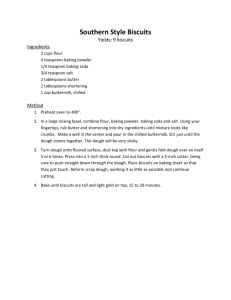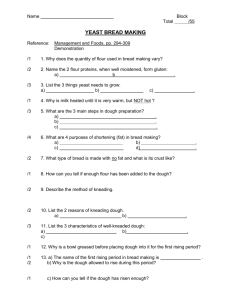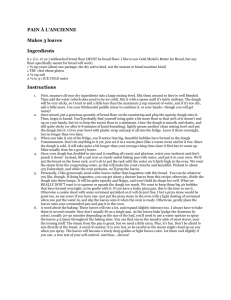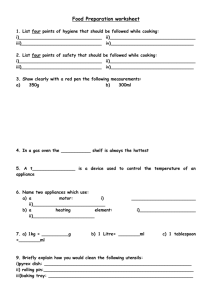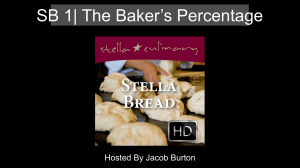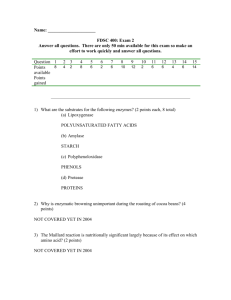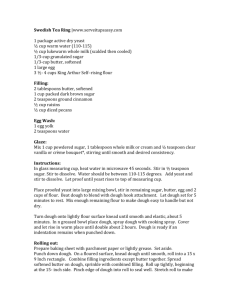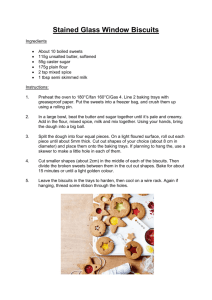Beth's Basic Bread Book - Jewish Egg Braid
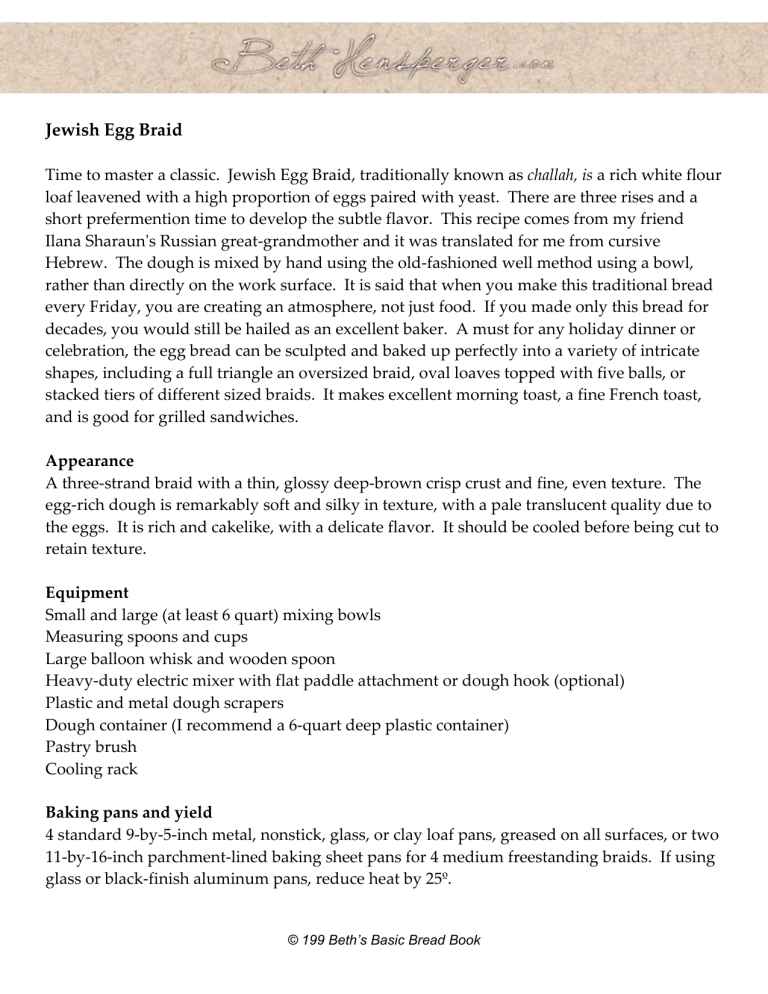
Jewish
Egg
Braid
Time to master a classic.
Jewish Egg Braid, traditionally known as challah, is a rich white flour loaf leavened with a high proportion of eggs paired with yeast.
There are three rises and a short prefermention time to develop the subtle flavor.
This recipe comes from my friend
Ilana Sharaun ʹ s Russian great ‐ grandmother and it was translated for me from cursive
Hebrew.
The dough is mixed by hand using the old ‐ fashioned well method using a bowl, rather than directly on the work surface.
It is said that when you make this traditional bread every Friday, you are creating an atmosphere, not just food.
If you made only this bread for decades, you would still be hailed as an excellent baker.
A must for any holiday dinner or celebration, the egg bread can be sculpted and baked up perfectly into a variety of intricate shapes, including a full triangle an oversized braid, oval loaves topped with five balls, or stacked tiers of different sized braids.
It makes excellent morning toast, a fine French toast, and is good for grilled sandwiches.
Appearance
A three ‐ strand braid with a thin, glossy deep ‐ brown crisp crust and fine, even texture.
The egg ‐ rich dough is remarkably soft and silky in texture, with a pale translucent quality due to the eggs.
It is rich and cakelike, with a delicate flavor.
It should be cooled before being cut to retain texture.
Equipment
Small and large (at least 6 quart) mixing bowls
Measuring spoons and cups
Large balloon whisk and wooden spoon
Heavy ‐ duty electric mixer with flat paddle attachment or dough hook (optional)
Plastic and metal dough scrapers
Dough container (I recommend a 6 ‐ quart deep plastic container)
Pastry brush
Cooling rack
Baking pans and yield
4 standard 9 ‐ by ‐ 5 ‐ inch metal, nonstick, glass, or clay loaf pans, greased on all surfaces, or two
11 ‐ by ‐ 16 ‐ inch parchment ‐ lined baking sheet pans for 4 medium freestanding braids.
If using glass or black ‐ finish aluminum pans, reduce heat by 25º.
© 199 Beth’s Basic Bread Book
Baking temperature 350º
Timetable
Total preparation time About 5 1/4 hours
Working time 25 minutes
Kneading time About 8 minutes
First rise 2 to 2 1/4 hours
Second rise 1 to 1 1/4 hours
Shaping time 5 to 10 minutes
Third rise 40 minutes
Baking time 40 to 45 minutes
About 7 1/2 cups unbleached all ‐ purpose flour
2 1/2 cups warm water (105º to 115º)
2 tablespoons (2 1/2 packages) active dry yeast
1/3 cup plus 1 tablespoon sugar
3 eggs
1/2 cup vegetable oil
2 teaspoons salt
Rich Egg Glaze
2 tablespoons sesame or poppy seeds
1.
Mixing the dough: In a large bowl, using the whisk, place 6 cups of the flour.
Make a well in the center with your hand and pour the 1/2 cup of the water into the center.
Sprinkle the yeast and 1 tablespoon of the sugar over the water.
Stir gently to dissolve (a bit of flour will also be incorporated) and let stand 15 minutes.
Add the remaining sugar, remaining water, eggs, oil, and salt to the well and mix with a large wooden spoon or your hand with the fingers outstretched until a shaggy mass of dough is formed.
Add the remaining flour,
1/2 cup at a time.
The dough will form a ball and pull away from the sides of the bowl.
This dough comes together quickly, so long mixing is not necessary.
Alternately, the dough can be mixed in the workbowl of a heavy ‐ duty electric mixer fitted with a paddle attachment.
2.
Kneading: Turn the dough out onto a lightly floured work surface with the plastic pastry scraper and knead by folding, stretching, and pulling until soft and springy, 5 to 8 minutes, dusting with flour only 1 tablespoon at a time, just enough as needed to prevent sticking.
The dough will be smooth and springy, but not dry.
© 199 Beth’s Basic Bread Book
3.
First and second rise: Place the dough in a lightly greased deep container.
Turn the dough once to coat the top and cover with pastic wrap.
Let rise at room temperature until double in bulk, about 2 to 2 1/4 hours.
Do not allow the dough to rise over double, as it has a tendency to tear and the baked loaf will not be as full volumed as it can be.
Gently deflate the dough with your fist, re ‐ cover and let rise again until doubled in bulk, about 1 to 1 1/4 hours.
4.
Shaping and third rise: Turn the dough out onto a lightly floured work surface to deflate.
Lightly grease the bottom and sides of the 9 ‐ by ‐ 5 ‐ inch loaf pans or line the baking sheet with parchment.
Without working the dough further, divide the dough into 4 equal portions.
Further divide each portion into 3 equal portions.
Roll each section under your palms into a rope that is tapered at each end.
Gently dust the work surface with flour (this keeps the shape more distinct during rising) that lightly coats each rope.
Be sure the ropes are of equal size and shape.
Place the 3 ropes parallel to each other.
Begin braiding starting in the center rather than at the ends for a more even shape.
Take one of the outside ropes and fold it over the center rope, then repeat the movement from the opposite side.
Continue by alternating the outside ropes over the center rope.
When completed, turn the dough around and repeat the procedure from the middle out to the other ends.
Adjust or press the braid to fix any irregularities.
Tuck the ends under and set into the loaf pans or place the loaves on the baking sheet for free ‐ standing loaves, pinching the ends into tapered points.
Brush the tops with some of the egg glaze.
Cover loosely with plastic wrap and let rise at room temperature until the dough is almost double in bulk and about 1 inch over the rims of the pans, about 40 minutes.
This bread needs only a three ‐ quarter proof before baking; if longer, it can collapse during baking.
Twenty minutes before baking, preheat the oven to 350º.
5.
Baking off and cooling: Brush the surface of the loaves a second time with the egg glaze and sprinkle with seeds or leave plain.
Place the pans on the center rack of the preheated oven and bake 40 to 45 minutes, or until the loaves are deep golden brown, the sides slightly contract from the pan, and sound hollow when tapped with your finger.
Remove the loaves from the pans immediately to a cooling rack.
Loaves are best slightly warm or at room temperature.
Storage
This bread has an excellent shelf life, staying moist about 3 days; it does not stale quickly.
Store wrapped in a plastic food storage bag at room temperature or freeze.
© 199 Beth’s Basic Bread Book
Baker ʹ s Notes
•
Many egg bread recipes, especially ones from Europe, use only egg yolks in the dough, rather than the whole egg.
This is because yolks are capable of producing a bit higher volume than whole eggs, probably a technique left over from a time when yeasts were more unreliable than today.
Substitute 1 whole egg for 2 yolks.
•
Eggs contribute richness, greater volume, structure building ‐ protein, and increased shelf life.
Oil is added to counteract the tendency of egg breads to dry out quickly.
•
Do not let the egg glaze drip down into the sides of the pan or the bread will stick.
•
This recipe can also be shaped as plain rectangular loaves, 1 or 2 large freeform braids
(check the size of your oven first) for celebrations, 3 spiral turban, or 2 large braided sesame crown wreaths.
•
This basic recipe can be dressed up nicely with 1 to 2 cups of chopped dried fruit and/or nuts, candied peels, grated cheese, or 1/4 cup chopped fresh herbs added.
•
Make a Cinnamon Egg Bread by rolling and coating the ropes in ground cinnamon before shaping the braid.
Specific Skills
•
Mixing an egg ‐ rich and oil ‐ rich straight dough by the well method.
•
Forming a 3 ‐ strand braid with ropes of dough.
•
Preparing an egg wash and applying a seed topping.
•
Introduction to the three ‐ quarter proof.
© 199 Beth’s Basic Bread Book
